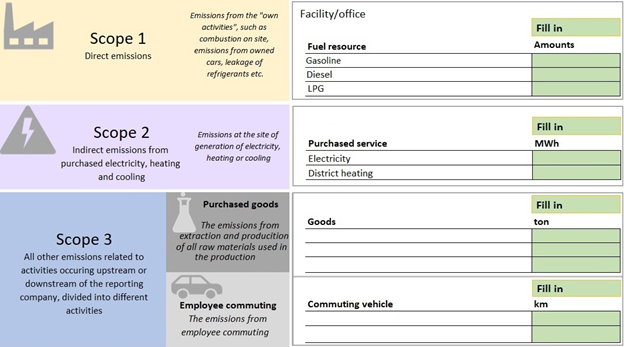Corporate Carbon Footprint
Assessing a company’s carbon footprint, also known as the greenhouse gas (GHG) footprint, is the most crucial step in reducing an organization’s climate impact. We help organizations assess and calculate their carbon footprint by following the international GHG Protocol Standard.
First, we generate a greenhouse gas inventory where we gather all data on greenhouse gas emissions (their sources, included activities, and emission amounts). Then, we calculate the organization’s carbon footprint based on the collected data and using the GHG calculation tool developed by our experts. Next, we compile a detailed carbon footprint report that consolidates the GHG inventory results and conclusions. In addition, the report includes various practical recommendations and options on how your organization can reduce its carbon footprint, become more climate neutral and more sustainable in general.
In addition to calculating the organization’s carbon footprint, we also perform product carbon footprint calculations – read more about the environmental product declaration (EPD) and lifecycle here.
Why Assess the Organization’s Carbon Footprint?
Measuring and managing an organization’s carbon footprint is important from both an environmental and organizational perspective. It offers several advantages and adds value, such as providing a market advantage as consumers are increasingly aware and prefer companies and products with a demonstrated commitment to sustainability. It also reveals the environmental impact of your company or a product and identifies bottlenecks in your business or production. Knowing the numeric value of your company’s carbon footprint, you can start consciously working on reducing it. We also offer our clients to develop a sustainability roadmap with specific recommendations on how to reduce the carbon footprint in the company.
Additionally, assessing the carbon footprint is particularly timely because, under the European Union’s Corporate Sustainability Reporting Directive (CSRD), large companies operating in the EU are now required to disclose sustainability-related information, including environmental, social, and governance (ESG) aspects. They must also develop and implement a strategy for reducing their carbon footprint. The reporting requirement applies to companies with more than 250 employees, a turnover of at least 40 million euros, and/or assets worth at least 20 million euros.
Building a Greenhouse Gas (GHG) Inventory
To calculate and assess the GHG footprint, we first create a greenhouse gas (GHG) inventory where we gather all data on your organization’s GHG emissions (included activities, emission sources, and emission amounts). According to the GHG Protocol Standard, the GHG inventory data is categorized into 3 scopes:
- Scope 1: Direct emissions from sources owned or controlled by the company (e.g., company vehicles, on-site energy production);
- Scope 2: Indirect emissions from purchased energy (e.g., purchased electricity, heat, and cooling);
- Scope 3: All other indirect emissions resulting from the company’s various activities and within the supply chain (e.g., purchased products, office equipment, employee commuting, business travels, waste generation etc).


Scope 1, 2 and 3 emissions categorization
Carbon Footprint Calculation Tool
After building the GHG inventory (which maps out where the organization’s GHG emissions occur), we develop a carbon footprint calculation tool specific to your organization. Then, we calculate your carbon footprint and identify where the largest GHG emissions occur. The calculated value reflects one typical operational year. The developed carbon calculation tool will be available for your ongoing use. It enables you to view the GHG footprint by all different scopes and activities/sources, such as purchased electricity, business travel, commuting, office equipment, waste, and purchased goods. This tool allows you to evaluate your GHG footprint over the years, providing valuable insights for your company’s continuous improvement.


Example of carbon footprint calculation tool
Carbon Footprint Report and Carbon Reduction Roadmap (Sustainability Roadmap)
After compiling a carbon footprint report, consolidating the GHG inventory data and carbon footprint calculation results, we develop a carbon reduction roadmap (sustainability roadmap) which provides your company various practical recommendations and effective tips for reducing carbon footprint in the future. This might include optimizing or eliminating certain activities and identifying cost-saving opportunities. The sustainability roadmap aligns with the company’s sustainability goals and considers the organization’s physical constraints.
Discover your organization’s carbon footprint with our assistance and receive practical guidance for reducing your emissions. By implementing sustainable practices, you will gain a competitive advantage as well as achieve cost savings.
Contact us today – our experts are ready to answer your questions and provide tailored advice to support your company’s sustainability journey!

Lauri Niemelä
+372 5886 6419
lauri@dge.ee
